Effect of Non-Saccharomyces Yeasts Derived from Traditional Fermented Foods on Beer Fermentation Characteristics and Flavor Profiles
Abstract
:1. Introduction
2. Materials and Methods
2.1. Materials
2.2. Methods
2.2.1. Isolation of Yeasts from Daqu and Fermented Grains
2.2.2. Strain Identification
2.2.3. Screening of the Non-Saccharomyces Yeast Strains
- Primary screening: growth ability in medium with maltose as the sole carbon source
- 2.
- First round of rescreening: evaluation of physiological characteristics
- 3.
- Second round of rescreening: Beer fermentation test
2.2.4. Fermentation Optimization of S. fibuligera G02
- Fermentation temperature optimization
- 2.
- Optimization of initial inoculation rates
- 3.
- Optimizing initial concentrations of iso-α-acids of wort
- 4.
- Validation of optimized fermentation parameters
- 5.
- Fermentation analysis.
2.2.5. Micro-Fermentation
- Beer fermentation set-up
- 2.
- Fermentation analysis.
2.2.6. Volatile Compounds Analysis
- HS-SPME
- 2.
- Chromatographic conditions for GC–MS analysis
2.2.7. Statistics
3. Results and Discussion
3.1. The Isolation of the Yeasts from Baijiu Daqu and Fermented Grains
3.2. Screening of the Non-Saccharomyces Yeast Strains
3.2.1. Primary Screening
3.2.2. First Round of Rescreening
3.2.3. Second Round of Rescreening: Beer Fermentation Test
3.3. Fermentation Optimization of S. fibuligera G02
3.4. Micro-Fermentation
3.4.1. Yeast Growth During Fermentation
3.4.2. Main Volatile Compounds
3.4.3. Calculation of Relative Odor Activity Value (rOAVs) and PCA
4. Conclusions
Supplementary Materials
Author Contributions
Funding
Institutional Review Board Statement
Informed Consent Statement
Data Availability Statement
Acknowledgments
Conflicts of Interest
Abbreviations
| MDPI | Multidisciplinary Digital Publishing Institute |
| DOAJ | Directory of Open Access Journals |
| TLA | Three letter acronym |
| LD | Linear dichroism |
References
- Denby, C.M.; Li, R.A.; Vu, V.T.; Costello, Z.; Lin, W.; Chan, L.J.G.; Williams, J.; Donaldson, B.; Bamforth, C.W.; Petzold, C.J.; et al. Industrial brewing yeast engineered for the production of primary flavor determinants in hopped beer. Nat. Commun. 2018, 9, 965. [Google Scholar] [CrossRef] [PubMed]
- De Flaviis, R.; Santarelli, V.; Grilli, S.; Sacchetti, G. An integrative multi-omics approach aimed to gain insight on the effect of composition, style, yeast, and wheat species on wheat craft beer flavour. Food Chem. 2024, 441, 138387. [Google Scholar] [CrossRef] [PubMed]
- Yang, Q.; Liang, N.; Chen, S.; Chen, J.; Chen, M.; Tu, J.; Xiang, Z. Unravelling the key flavor components of beer based on a new online recombination olfactometry of mixed targeted compounds. Food Chem. 2025, 479. [Google Scholar] [CrossRef] [PubMed]
- Olšovská, J.; Vrzal, T.; Štěrba, K.; Slabý, M.; Kubizniaková, P.; Čejka, P. The chemical profiling of fatty acids during the brewing process. J. Sci. Food Agric. 2019, 99, 1772–1779. [Google Scholar] [CrossRef]
- Gallone, B.; Steensels, J.; Prahl, T.; Soriaga, L.; Saels, V.; Herrera-Malaver, B.; Merlevede, A.; Roncoroni, M.; Voordeckers, K.; Miraglia, L.; et al. Domestication and divergence of Saccharomyces cerevisiae beer yeasts. Cell 2016, 166, 1397–1410. [Google Scholar] [CrossRef]
- Basso, R.F.; Alcarde, A.R.; Portugal, C.B. Could non-Saccharomyces yeasts contribute to innovative brewing fermentations? Food Res. Int. 2016, 86, 112–120. [Google Scholar] [CrossRef]
- Jaeger, S.R.; Worch, T.; Phelps, T.; Jin, D.; Cardello, A.V. Preference segments among declared craft beer drinkers: Perceptual, attitudinal, and behavioral responses underlying craft-style vs. traditional-style flavor preferences. Food Qual. Prefer. 2020, 82, 103884. [Google Scholar] [CrossRef]
- Vilela, A. Modulating wine pleasantness throughout wine-yeast co-inoculation or sequential inoculation. Fermentation 2020, 6, 22. [Google Scholar] [CrossRef]
- Capece, A.; Romaniello, R.; Pietrafesa, A.; Siesto, G.; Pietrafesa, R.; Zambuto, M.; Romano, P. Use of Saccharomyces cerevisiae var. boulardii in co-fermentations with S. cerevisiae for the production of craft beers with potential healthy value-added. Int. J. Food Microbiol. 2018, 284, 22–30. [Google Scholar] [CrossRef]
- Aguiar-Cervera, J.; Visinoni, F.; Zhang, P.; Hollywood, K.; Vrhovsek, U.; Severn, O.; Delneri, D. Effect of Hanseniaspora vineae and Saccharomyces cerevisiae co-fermentations on aroma compound production in beer. Food Microbiol. 2024, 123, 104585. [Google Scholar] [CrossRef]
- Walker, G.; Stewart, G. Saccharomyces cerevisiae in the production of fermented beverages. Beverages 2016, 2, 30. [Google Scholar] [CrossRef]
- Cao, K.; Wu, J.; Wan, X.; Hou, Y.; Zhang, C.; Wang, Y.; Zhang, L.; Yang, W.; He, Y.; Wu, R. Impact of non-Saccharomyces yeasts derived from traditional fermented foods on beer aroma: Analysis based on HS-SPME-GC/MS combined with chemometrics. Food Res. Int. 2024, 187, 114366. [Google Scholar] [CrossRef] [PubMed]
- Methner, Y.; Magalhaes, F.; Raihofer, L.; Zarnkow, M.; Jacob, F.; Hutzler, M. Beer fermentation performance and sugar uptake of Saccharomycopsis fibuligera: A novel option for low-alcohol beer. Front. Microbiol. 2022, 13, 1011155. [Google Scholar] [CrossRef]
- Holt, S.; Mukherjee, V.; Lievens, B.; Verstrepen, K.J.; Thevelein, J.M. Bioflavoring by non-conventional yeasts in sequential beer fermentations. Food Microbiol. 2018, 72, 55–66. [Google Scholar] [CrossRef]
- Wu, D.; Chen, Z.; Lv, Y.; Yang, L.; Liu, H.; Qiu, R.; Xue, H.; Li, J.; Lu, J.; Cai, G. Coculturing of non-Saccharomyces cerevisiae and Saccharomyces cerevisiae for improving the aroma quality and antioxidant characteristics of beer with Yuan’an yellow tea. Food Biosci. 2024, 58, 103725. [Google Scholar] [CrossRef]
- Jahn, L.J.; Rekdal, V.M.; Sommer, M.O.A. Microbial foods for improving human and planetary health. Cell 2023, 186, 469–478. [Google Scholar] [CrossRef]
- Cubillos, F.A.; Gibson, B.; Grijalva-Vallejos, N.; Krogerus, K.; Nikulin, J. Bioprospecting for brewers: Exploiting natural diversity for naturally diverse beers. Yeast 2019, 36, 383–398. [Google Scholar] [CrossRef]
- Grijalva-Vallejos, N.; Aranda, A.; Matallana, E. Evaluation of yeasts from Ecuadorian chicha by their performance as starters for alcoholic fermentations in the food industry. Int. J. Food Microbiol. 2020, 317, 108462. [Google Scholar] [CrossRef]
- Blasche, S.; Kim, Y.; Mars, R.A.T.; Machado, D.; Maansson, M.; Kafkia, E.; Milanese, A.; Zeller, G.; Teusink, B.; Nielsen, J.; et al. Metabolic cooperation and spatiotemporal niche partitioning in a kefir microbial community. Nat. Microbiol. 2021, 6, 196–208. [Google Scholar] [CrossRef]
- Resende, L.V.; Pinheiro, L.K.; Miguel, M.; Ramos, C.L.; Vilela, D.M.; Schwan, R.F. Microbial community and physicochemical dynamics during the production of ‘Chicha’, a traditional beverage of Indigenous people of Brazil. World J. Microbiol. Biotechnol. 2018, 34, 46. [Google Scholar] [CrossRef]
- Kang, J.; Xue, Y.; Chen, X.; Han, B.Z. Integrated multi-omics approaches to understand microbiome assembly in Jiuqu, a mixed-culture starter. Compr. Rev. Food Sci. Food Saf. 2022, 21, 4076–4107. [Google Scholar] [CrossRef] [PubMed]
- Kang, J.; Chen, X.; Han, B.Z.; Xue, Y. Insights into the bacterial, fungal, and phage communities and volatile profiles in different types of Daqu. Food Res. Int. 2022, 158, 111488. [Google Scholar] [CrossRef] [PubMed]
- Wang, J.W.; Han, P.J.; Han, D.Y.; Zhou, S.; Li, K.; He, P.Y.; Zhen, P.; Yu, H.X.; Liang, Z.R.; Wang, X.W.; et al. Genetic diversity and population structure of the amylolytic yeast Saccharomycopsis fibuligera associated with Baijiu fermentation in China. J. Microbiol. 2021, 59, 753–762. [Google Scholar] [CrossRef] [PubMed]
- Yang, S.; Yan, D.; Zou, Y.; Mu, D.; Li, X.; Shi, H.; Luo, X.; Yang, M.; Yue, X.; Wu, R.; et al. Fermentation temperature affects yogurt quality: A metabolomics study. Food Biosci. 2021, 42, 101104. [Google Scholar] [CrossRef]
- Visinoni, F.; Zhang, P.; Hollywood, K.A.; Carlin, S.; Vrhovsek, U.; Winterburn, J.; Delneri, D. Volatile aroma compound production is affected by growth rate in S. cerevisiae. Appl. Environ. Microbiol. 2022, 88, e01509-22. [Google Scholar] [CrossRef]
- Michel, M.; Kopecká, J.; Meier-Dörnberg, T.; Zarnkow, M.; Jacob, F.; Hutzler, M. Screening for new brewing yeasts in the non-Saccharomyces sector with Torulaspora delbrueckii as a model. Yeast 2016, 33, 129–144. [Google Scholar] [CrossRef]
- Zhang, G.; Xiao, P.; Xu, Y.; Li, H.; Li, H.; Sun, J.; Sun, B. Isolation and characterization of yeast with benzenemethanethiol synthesis ability isolated from Baijiu Daqu. Foods 2023, 12, 2464. [Google Scholar] [CrossRef]
- Fan, G.; Liu, P.; Chang, X.; Yin, H.; Cheng, L.; Teng, C.; Gong, Y.; Li, X. Isolation and identification of a high-yield ethyl caproate-producing yeast from Daqu and optimization of its fermentation. Front. Microbiol. 2021, 12, 663744. [Google Scholar] [CrossRef]
- Araujo Piraine, R.E.; Nickens, D.G.; Sun, D.J.; Leivas Leite, F.P.; Bochman, M.L. Isolation of wild yeasts from Olympic National Park and Moniliella megachiliensis ONP131 physiological characterization for beer fermentation. Food Microbiol. 2022, 104, 103974. [Google Scholar] [CrossRef]
- Bourbon-Melo, N.; Palma, M.; Rocha, M.P.; Ferreira, A.; Bronze, M.R.; Elias, H.; Sá-Correia, I. Use of Hanseniaspora guilliermondii and Hanseniaspora opuntiae to enhance the aromatic profile of beer in mixed-culture fermentation with Saccharomyces cerevisiae. Food Microbiol. 2021, 95, 103678. [Google Scholar] [CrossRef]
- Elsemman, I.E.; Rodriguez Prado, A.; Grigaitis, P.; Garcia Albornoz, M.; Harman, V.; Holman, S.W.; van Heerden, J.; Bruggeman, F.J.; Bisschops, M.M.M.; Sonnenschein, N.; et al. Whole-cell modeling in yeast predicts compartment-specific proteome constraints that drive metabolic strategies. Nat. Commun. 2022, 13, 801. [Google Scholar] [CrossRef] [PubMed]
- Tan, M.; Caro, Y.; Shum-Cheong-Sing, A.; Robert, L.; François, J.M.; Petit, T. Evaluation of mixed-fermentation of Saccharomyces cerevisiae with Saprochaete suaveolens to produce natural fruity beer from industrial wort. Food Chem. 2021, 346, 128804. [Google Scholar] [CrossRef] [PubMed]
- Yin, H.; He, Y.; Dong, J.; Lu, J. Transcriptional profiling of amino acid supplementation and impact on aroma production in a lager yeast fermentation. J. Inst. Brew. 2018, 124, 425–433. [Google Scholar] [CrossRef]
- Matraxia, M.; Alfonzo, A.; Prestianni, R.; Francesca, N.; Gaglio, R.; Todaro, A.; Alfeo, V.; Perretti, G.; Columba, P.; Settanni, L.; et al. Non-conventional yeasts from fermented honey by-products: Focus on Hanseniaspora uvarumstrains for craft beer production. Food Microbiol. 2021, 99, 103806. [Google Scholar] [CrossRef]
- Paszkot, J.; Gasiński, A.; Kawa-Rygielska, J. Evaluation of volatile compound profiles and sensory properties of dark and pale beers fermented by different strains of brewing yeast. Sci. Rep. 2023, 13, 6725. [Google Scholar] [CrossRef]
- Hinojosa-Avila, C.R.; García-Gamboa, R.; Chedraui-Urrea, J.J.T.; García-Cayuela, T. Exploring the potential of probiotic-enriched beer: Microorganisms, fermentation strategies, sensory attributes, and health implications. Food Res. Int. 2024, 175, 113717. [Google Scholar] [CrossRef]
- Tan, Y.; Du, H.; Zhang, H.; Fang, C.; Jin, G.; Chen, S.; Wu, Q.; Zhang, Y.; Zhang, M.; Xu, Y. Geographically associated fungus-bacterium interactions contribute to the formation of geography-dependent flavor during high-complexity spontaneous fermentation. Microbiol. Spectr. 2022, 10, e0184422. [Google Scholar] [CrossRef]
- Xu, Y.; Qiao, X.; He, L.; Wan, W.; Xu, Z.; Shu, X.; Yang, C.; Tang, Y. Airborne microbes in five important regions of Chinese traditional distilled liquor (Baijiu) brewing: Regional and seasonal variations. Front. Microbiol. 2024, 14, 1324722. [Google Scholar] [CrossRef]
- Langenaeken, N.A.; De Schepper, C.F.; De Schutter, D.P.; Courtin, C.M. Carbohydrate content and structure during malting and brewing: A mass balance study. J. Inst. Brew. 2020, 126, 253–262. [Google Scholar] [CrossRef]
- Narayanan, V.; Sànchez, I.; Nogué, V.; van Niel, E.W.J.; Gorwa-Grauslund, M.F. Adaptation to low pH and lignocellulosic inhibitors resulting in ethanolic fermentation and growth of Saccharomyces cerevisiae. AMB Express 2016, 6, 59. [Google Scholar] [CrossRef]
- Methner, Y.; Hutzler, M.; Matoulková, D.; Jacob, F.; Michel, M. Screening for the brewing ability of different non-Saccharomyces yeasts. Fermentation 2019, 5, 101. [Google Scholar] [CrossRef]
- Zhang, S.; Li, L.; Tian, J.; Wang, B.; Yang, T. Problems and countermeasures of ethanol stress in craft beer brewing. Food Ferment. Ind. 2022, 48, 280–286. [Google Scholar] [CrossRef]
- Yang, T.; Zhang, S.; Li, L.; Tian, J.; Li, X.; Pan, Y. Screening and transcriptomic analysis of the ethanol-tolerant mutant Saccharomyces cerevisiae YN81 for high-gravity brewing. Front. Microbiol. 2022, 13, 976321. [Google Scholar] [CrossRef] [PubMed]
- Yang, T.; Zhang, S.; Pan, Y.; Li, X.; Liu, G.; Sun, H.; Zhang, R.; Zhang, C. Breeding of high-tolerance yeast by adaptive evolution and high-gravity brewing of mutant. J. Sci. Food Agric. 2024, 104, 686–697. [Google Scholar] [CrossRef]
- Hong, K.Q.; Fu, X.M.; Lei, F.F.; Chen, D.; He, D.P. Selection of Salt-Tolerance and Ester-Producing Mutant Saccharomyces cerevisiae to Improve Flavour Formation of Soy Sauce during Co-Fermentation with Torulopsis globosa. Foods. 2023, 12, 3449. [Google Scholar] [CrossRef]
- Allen, F. Gose: Brewing a Classic German Beer for the Modern Era; Brewers Publications: Boulder, CO, USA, 2018. [Google Scholar]
- Castro, R.; Díaz, A.B.; Durán-Guerrero, E.; Lasanta, C. Influence of different fermentation conditions on the analytical and sensory properties of craft beer: Hopping, fermentation temperature, and yeast strain. J. Food Compos. Anal. 2022, 106, 104278. [Google Scholar] [CrossRef]
- Canonico, L.; Agarbati, A.; Comitini, F.; Ciani, M. Unravelling the potential of non-conventional yeasts and recycled brewers spent grains (BSG) for non-alcoholic and low alcohol beer (NABLAB). LWT—Food Sci. Technol. 2023, 190, 115528. [Google Scholar] [CrossRef]
- Postigo, V.; Sanz, P.; García, M.; Arroyo, T. Impact of Non-Saccharomyces Wine Yeast Strains on Improving Healthy Characteristics and the Sensory Profile of Beer in Sequential Fermentation. Foods 2022, 11, 2029. [Google Scholar] [CrossRef]
- Gibson, B.R.; Lawrence, S.J.; Leclaire, J.P.R. The effect of temperature on fermentation and beer volatiles at an industrial scale. J. Ind. Microbiol. Biotechnol. 2013, 40, 437–447. [Google Scholar] [CrossRef]
- Rutnik, K.; Ocvirk, M.; Košir, I.J. The Impact of Hop Freshness on Kettle-Hopped Beers. Foods 2023, 12, 4353. [Google Scholar] [CrossRef]
- Steenackers, B.; De Cooman, L.; De Vos, D. Chemical transformations of characteristic hop secondary metabolites in relation to beer properties and the brewing process: A review. Food Chem. 2015, 172, 742–756. [Google Scholar] [CrossRef] [PubMed]
- Duarte, P.F.; Nascimento, L.H.D.; Bandiera, V.J.; Fischer, B.; Fernandes, I.A.; Paroul, N.; Junges, A. Exploring the versatility of hop essential oil (Humulus lupulus L.): Bridging brewing traditions with modern industry applications. Ind. Crops Prod. 2024, 218, 118974. [Google Scholar] [CrossRef]
- Mellor, D.D.; Hanna-Khalil, B.; Carson, R. A Review of the Potential Health Benefits of Low Alcohol and Alcohol-Free Beer: Effects of Ingredients and Craft Brewing Processes on Potentially Bioactive Metabolites. Beverages 2020, 6, 25. [Google Scholar] [CrossRef]
- Canonico, L.; Comitini, F.; Ciani, M. Torulaspora delbrueckii contribution in mixed brewing fermentations with different Saccharomyces cerevisiae strains. Int. J. Food Microbiol. 2017, 259, 7–13. [Google Scholar] [CrossRef]
- Lee, S.M.; Jung, J.H.; Seo, J.A.; Kim, Y.S. Bioformation of volatile and nonvolatile metabolites by Saccharomycopsis fibuligera KJJ81 cultivated under different conditions—Carbon sources and cultivation times. Molecules 2018, 23, 2762. [Google Scholar] [CrossRef]
- Van Rijswijck, I.M.H.; Wolkers-Rooijackers, J.C.M.; Abee, T.; Smid, E.J. Performance of non-conventional yeasts in co-culture with brewers’ yeast for steering ethanol and aroma production. Microb. Biotechnol. 2017, 10, 1591–1602. [Google Scholar] [CrossRef]
- Dimopoulou, M.; Goulioti, E.; Troianou, V.; Toumpeki, C.; Paramithiotis, S.; Gosselin, Y.; Dorignac, E.; Papadopoulos, G.; Kotseridis, Y. Effect of Saccharomyces cerevisiae and Saccharomyces pastorianus Co-Inoculation on Alcoholic Fermentation Behavior and Aromatic Profile of Sauvignon Blanc Wine. Fermentation 2022, 8, 539. [Google Scholar] [CrossRef]
- Park, M.K.; Kim, Y.S. Mass spectrometry-based metabolomics approach on the elucidation of volatile metabolites formation in fermented foods: A mini review. Food Sci. Biotechnol. 2021, 30, 881–890. [Google Scholar] [CrossRef]
- Han, X.; Qin, Q.; Li, C.; Zhao, X.; Song, F.; An, M.; Chen, Y.; Wang, X.; Huang, W.; Zhan, J.; et al. Application of non-Saccharomyces yeasts with high β-glucosidase activity to enhance terpene-related floral flavor in craft beer. Food Chem. 2023, 404, 134726. [Google Scholar] [CrossRef]
- Wu, Y.; Li, Z.; Zou, S.; Dong, L.; Lin, X.; Chen, Y.; Zhang, S.; Ji, C.; Liang, H. Chemical Composition and Flavor Characteristics of Cider Fermented with Saccharomyces cerevisiae and non-Saccharomyces cerevisiae. Foods 2023, 12, 3565. [Google Scholar] [CrossRef]
- Boro, N.; Borah, A.; Sarma, R.L.; Narzary, D. Beer production potentiality of some non-Saccharomyces yeast obtained from a traditional beer starter emao. Braz. J. Microbiol. 2022, 53, 1515–1531. [Google Scholar] [CrossRef] [PubMed]
- Sun, L.; Gao, Y.; Sun, R.; Liu, L.; Lin, L.; Zhang, C. Metabolic and tolerance engineering of Komagataella phaffii for 2-phenylethanol production through genome-wide scanning. Biotechnol. Biofuels Bioprod. 2024, 17, 107. [Google Scholar] [CrossRef] [PubMed]
- Zhao, D.; Shi, D.; Sun, J.; Li, H.; Zhao, M.; Sun, B. Quantification and cytoprotection by vanillin, 4-methylguaiacol and 4-ethylguaiacol against AAPH-induced abnormal oxidative stress in HepG2 cells. RSC Adv. 2018, 8, 35474–35484. [Google Scholar] [CrossRef] [PubMed]
- Zhao, D.R.; Jiang, Y.S.; Sun, J.Y.; Li, H.H.; Luo, X.L.; Zhao, M.M. Anti-inflammatory mechanism involved in 4-ethylguaiacol-mediated inhibition of LPS-induced inflammation in THP-1 cells. J. Agric. Food Chem. 2019, 67, 1230–1243. [Google Scholar] [CrossRef]
- Zhao, D.; Sun, J.; Sun, B.; Zhao, M.; Zheng, F.; Huang, M.; Sun, X.; Li, H. Intracellular antioxidant effect of vanillin, 4-methylguaiacol and 4-ethylguaiacol: Three components in Chinese Baijiu. RSC Adv. 2017, 7, 46395–46405. [Google Scholar] [CrossRef]
- Wang, M.Q.; Ma, W.J.; Shi, J.; Zhu, Y.; Lin, Z.; Lv, H.P. Characterization of the key aroma compounds in Longjing tea using stir bar sorptive extraction (SBSE) combined with gas chromatography-mass spectrometry (GC-MS), gas chromatography-olfactometry (GC-O), odor activity value (OAV), and aroma recombination. Food Res. Int. 2020, 130, 108908. [Google Scholar] [CrossRef]
- Li, S.; Bi, P.; Sun, N.; Gao, Z.; Chen, X.; Guo, J. Effect of sequential fermentation with four non-Saccharomyces and Saccharomyces cerevisiae on nutritional characteristics and flavor profiles of kiwi wines. J. Food Compos. Anal. 2022, 109, 104480. [Google Scholar] [CrossRef]
- Meilgaard, M.C. Flavor chemistry of beer: Part II: Flavor and threshold of 239 aroma volatiles. MBAA Tech. Q. 1975, 12, 151–168. [Google Scholar]
- Jolly, N.; Augustyn, O.; Pretorius, I.S. The role and use of non-Saccharomyces yeasts in wine production. S. Afr. J. Enol. Vitic. 2017, 27, 15–39. [Google Scholar] [CrossRef]
- Han, X.; Qing, X.; Yang, S.; Li, R.; Zhan, J.; You, Y.; Huang, W. Study on the diversity of non-Saccharomyces yeasts in Chinese wine regions and their potential in improving wine aroma by β-glucosidase activity analyses. Food Chem. 2021, 360, 129886. [Google Scholar] [CrossRef]
- Núñez, L.; Serratosa, M.P.; Godoy, A.; Fariña, L.; Dellacassa, E.; Moyano, L. Comparison of physicochemical properties, amino acids, mineral elements, total phenolic compounds, and antioxidant capacity of Cuban fruit and rice wines. Food Sci. Nutr. 2021, 9, 3673–3682. [Google Scholar] [CrossRef] [PubMed]
- Giannetti, V.; Mariani, M.B.; Torrelli, P.; Marini, F. Flavour component analysis by HS-SPME/GC-MS and chemometric modeling to characterize Pilsner-style Lager craft beers. Microchem. J. 2019, 149, 103991. [Google Scholar] [CrossRef]
- Olaniran, A.O.; Hiralal, L.; Mokoena, M.P.; Pillay, B. Flavour-active volatile compounds in beer: Production, regulation and control. J. Inst. Brew. 2017, 123, 13–23. [Google Scholar] [CrossRef]
- Wei, J.; Zhang, Y.; Yuan, Y.; Dai, L.; Yue, T. Characteristic fruit wine production via reciprocal selection of juice and non-Saccharomyces species. Food Microbiol. 2019, 79, 66–74. [Google Scholar] [CrossRef]
- Yuan, H.; Sun, Q.; Wang, L.; Fu, Z.; Zhou, T.; Ma, J.; Liu, X.; Fan, G.; Teng, C. Optimization of High-Density Fermentation Conditions for Saccharomycopsis fibuligera Y1402 through Response Surface Analysis. Foods 2024, 13, 1546. [Google Scholar] [CrossRef]

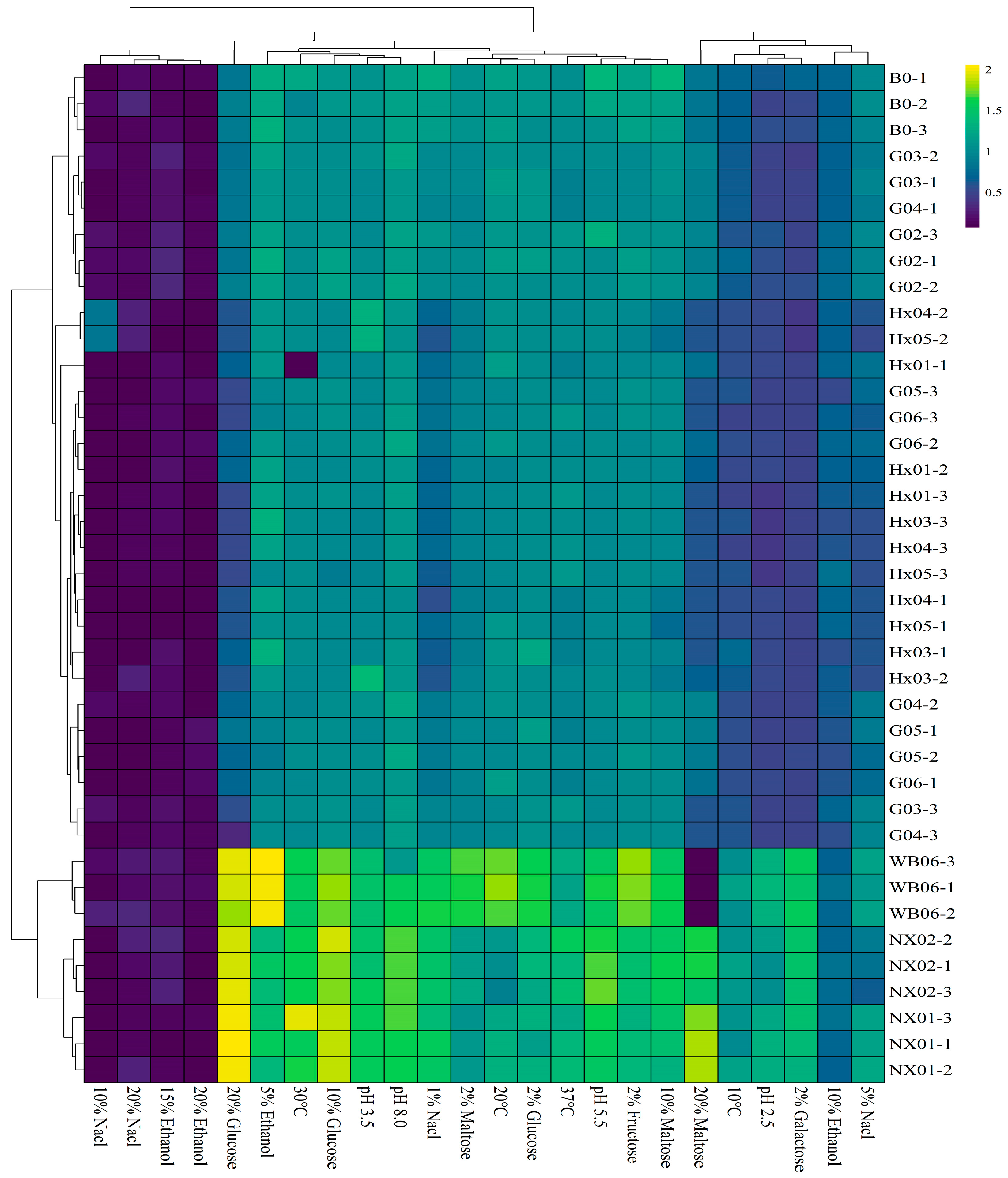
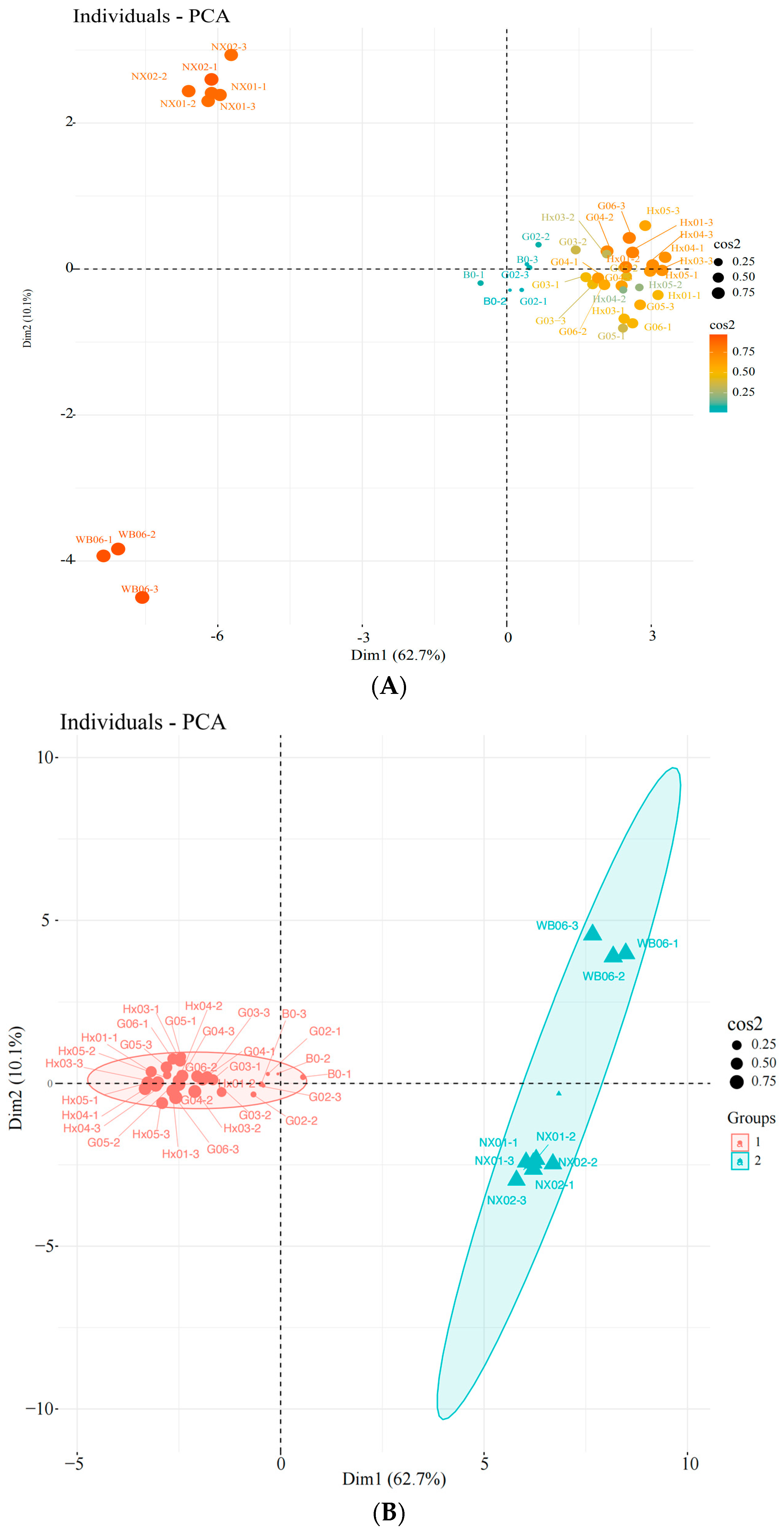


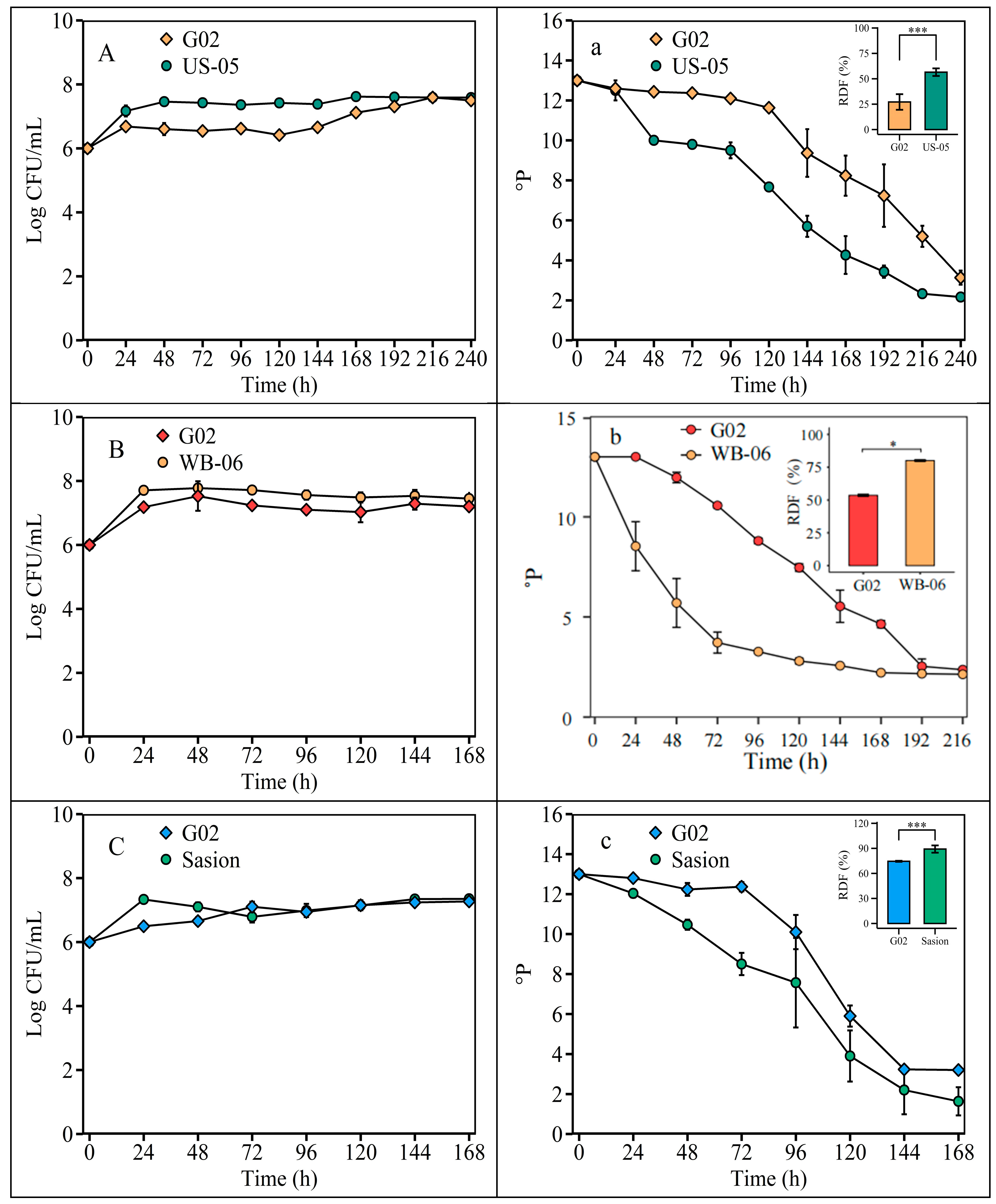
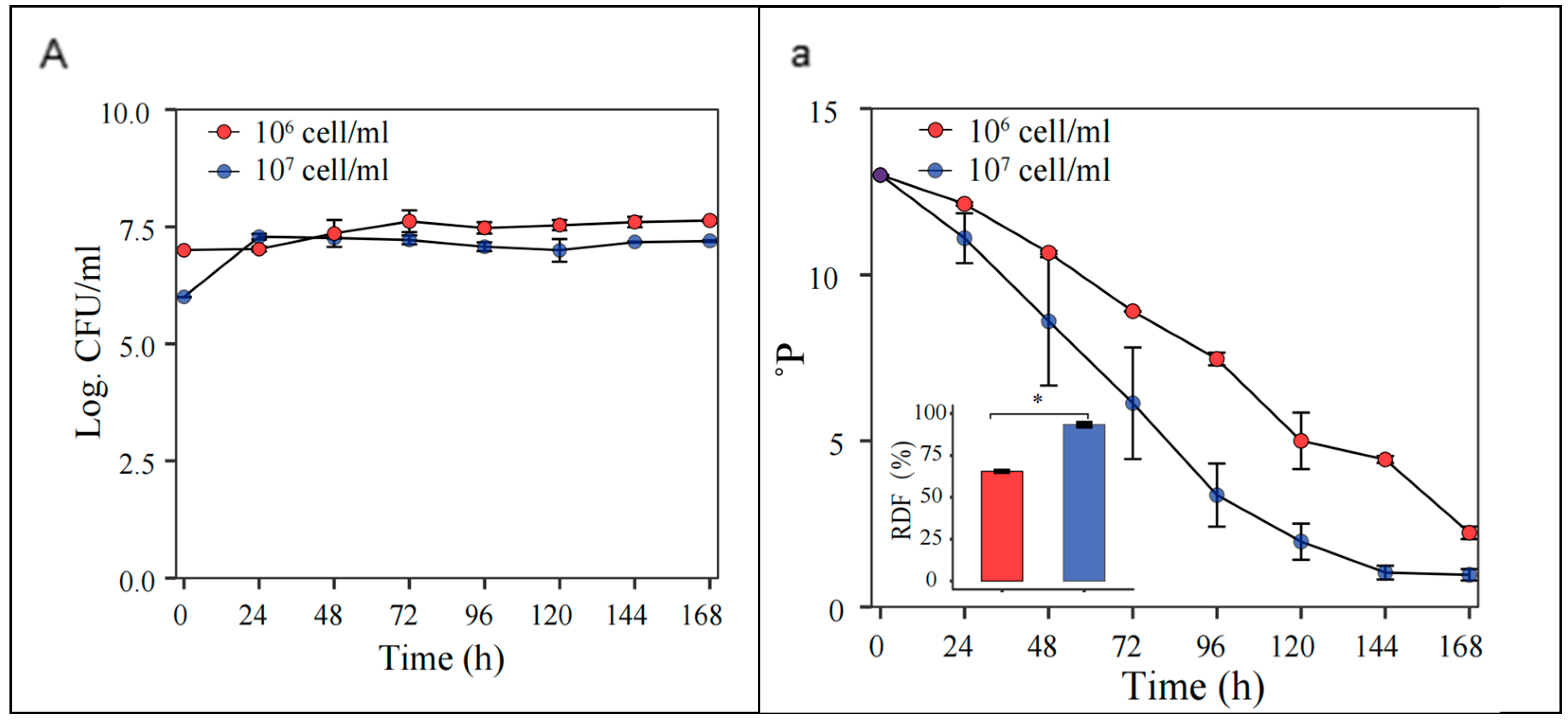

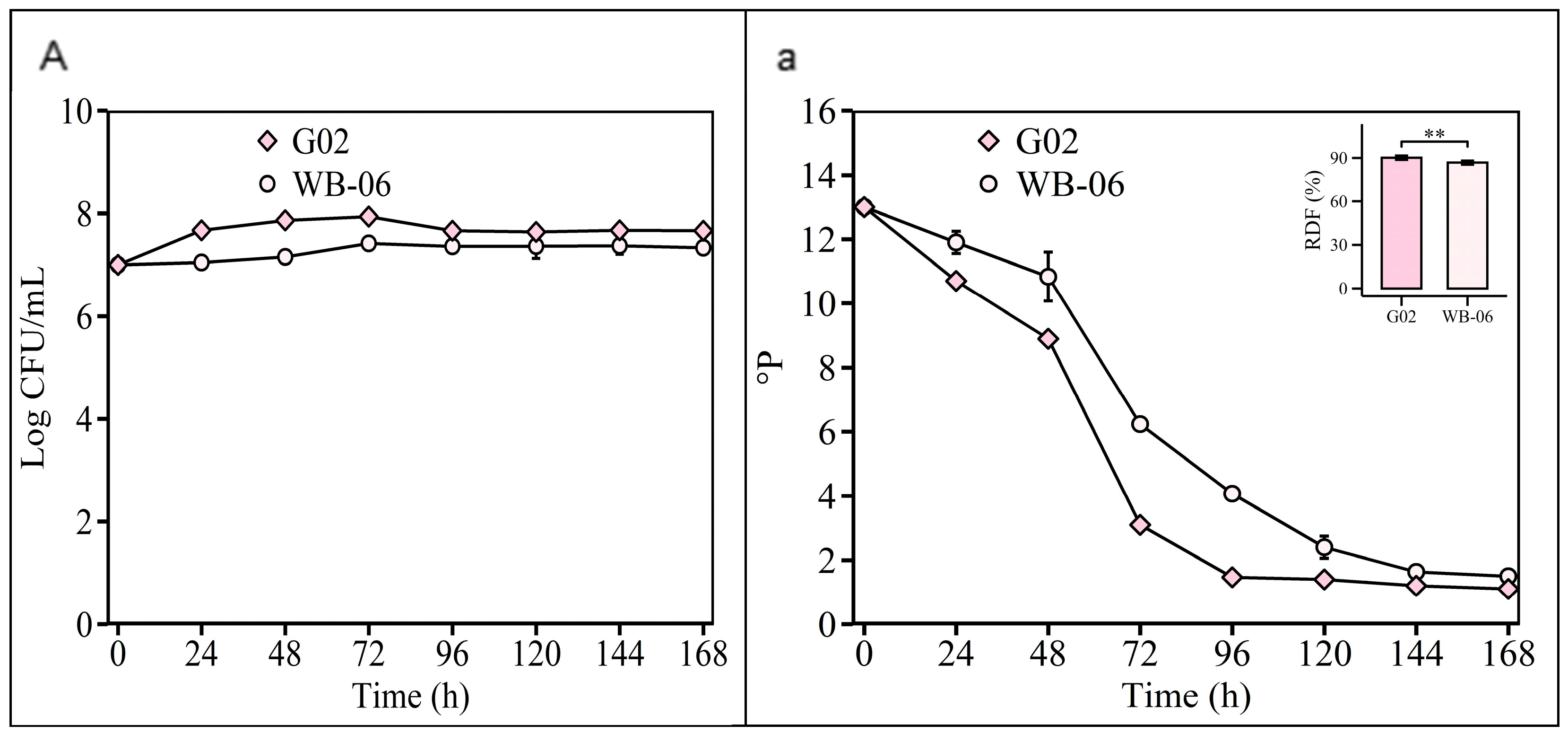

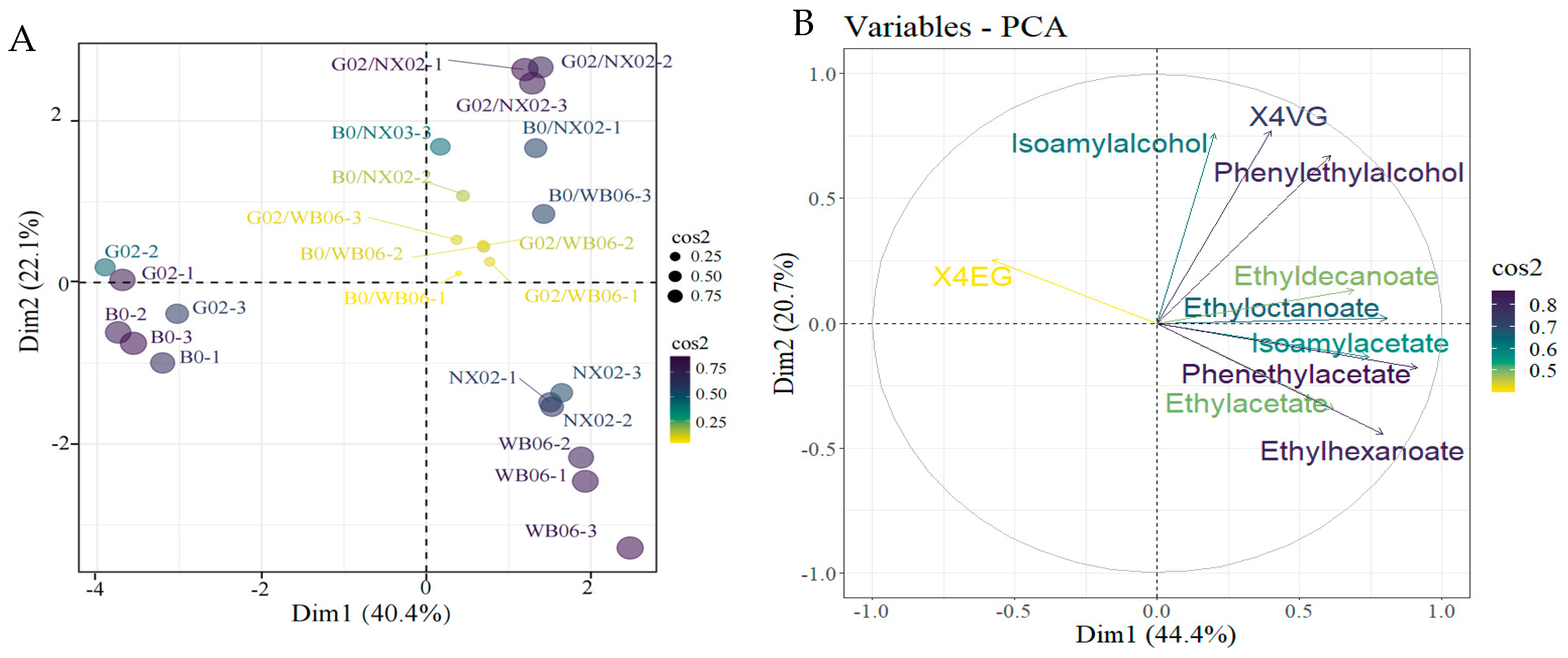
| Strain | Top Hit | Identity | NCBI Accession n. | Query Cover | Origin |
|---|---|---|---|---|---|
| G02 | Saccharomycopsis fibuligera | 100% | KX904348.1 | 100% | Sauce-flavor fermented grain |
| G03 | Saccharomycopsis fibuligera | 100% | MG518196.1 | 100% | Sauce-flavor fermented grain |
| G04 | Saccharomycopsis fibuligera | 100% | KX376260.1 | 100% | Sauce-flavor fermented grain |
| G05 | Saccharomycopsis fibuligera | 100% | OR786903.1 | 100% | Sauce-flavor fermented grain |
| G06 | Saccharomycopsis fibuligera | 100% | OR786905.1 | 100% | Sauce-flavor fermented grain |
| Hd01 | Saccharomycopsis fibuligera | 100% | MK722491.1 | 100% | Sauce-flavor Daqu |
| Hd02 | Saccharomycopsis fibuligera | 100% | MK722478.1 | 100% | Sauce-flavor Daqu |
| Hd03 | Saccharomycopsis fibuligera | 100% | MK722491.1 | 100% | Sauce-flavor Daqu |
| Hd04 | Saccharomycopsis fibuligera | 100% | MK722491.1 | 100% | Sauce-flavor Daqu |
| Hd05 | Saccharomycopsis fibuligera | 100% | MK373304.1 | 100% | Sauce-flavor Daqu |
| Hx01 | Saccharomycopsis fibuligera | 100% | MN648845.1 | 100% | Light-flavor Daqu |
| Hx02 | Saccharomycopsis fibuligera | 100% | KF717372.1 | 100% | Light-flavor Daqu |
| Hx03 | Saccharomycopsis fibuligera | 100% | KY705007.1 | 100% | Light-flavor Daqu |
| Hx04 | Saccharomycopsis fibuligera | 100% | JX6457191.1 | 100% | Light-flavor Daqu |
| Hx05 | Saccharomycopsis fibuligera | 100% | MN497048.1 | 100% | Light-flavor Daqu |
| Hx06 | Saccharomycopsis fibuligera | 100% | KU956955.1 | 100% | Light-flavor Daqu |
| Hh01 | Saccharomycopsis fibuligera | 100% | KY705007.1 | 100% | Light-flavor Daqu |
| Hh02 | Saccharomycopsis fibuligera | 100% | JX645719.1 | 100% | Light-flavor Daqu |
| Hh03 | Saccharomycopsis fibuligera | 100% | MT577806.1 | 100% | Light-flavor Daqu |
| Hh04 | Saccharomycopsis fibuligera | 100% | MK497048.1 | 100% | Light-flavor Daqu |
| Hh05 | Saccharomycopsis fibuligera | 100% | CP012823.1 | 100% | Light-flavor Daqu |
| Hh06 | Saccharomycopsis fibuligera | 100% | CP095750.1 | 100% | Light-flavor Daqu |
| NX01 | Saccharomyces cerevisiae | 100% | KY109416.1 | 100% | Strong-flavor Daqu |
| NX02 | Saccharomyces cerevisiae | 100% | KY441458.1 | 100% | Strong-flavor Daqu |
| NO. 1 | Aroma Compounds (mg /L 2) | |||||||||
|---|---|---|---|---|---|---|---|---|---|---|
| Isoamyl Alcohol | 2-Phenylethyl Alcohol | Ethyl Acetate | Isoamyl Acetate | Ethyl Hexanoate | Ethyl Caprylate | Phenylethyl Acetate | Ethyl Decanoate | 4VG | 4EG | |
| WB-06 | 7.72 ± 0.47 ab | 10.86 ± 2.03 ab | 1.58 ± 0.61 c | 1.48 ± 0.15 b | 0.85 ± 0.23 bc | 6.77 ± 1.76 a | 3.03 ± 0.14 c | 3.57 ± 0.7 a | 0.92 ± 0.20 b | nd b |
| NX02 | 7.26 ± 0.32 ab | 9.23 ± 1.02 bc | 1.11 ± 0.72 cd | 1.90 ± 0.17 b | 0.91 ± 0.11 b | 4.66 ± 0.43 b | 4.38 ± 0.23 a | 3.13 ± 0.21 b | ND c | nd b |
| B0 | 4.05 ± 0.87 b | 6.10 ± 2.29 c | ND d | 0.36 ± 0.02 c | ND d | 0.43 ± 0.34 d | 0.22 ± 0.02 d | 0.01 ± 0.00 d | ND c | 0.46 ± 0.01 b |
| G02 | 8.94 ± 0.49 ab | 5.10 ± 2.18 c | 0.67 ± 0.00 d | 0.36 ± 0.01 d | ND d | 0.54 ± 0.32 d | 0.36 ± 0.12 d | 0.01 ± 0.01 e | ND c | 1.40 ± 0.13 a |
| B0/WB-06 | 8.99 ± 1.23 ab | 9.95 ± 1.19 b | 2.26 ± 0.74 b | 2.11 ± 0.37 ab | 0.64 ± 0.19 c | 2.30 ± 0.64 c | 2.95 ± 0.53 c | 0.71 ± 0.27 cd | 1.15 ± 0.24 a | 0.45 ± 0.02 b |
| B0/NX02 | 5.89 ± 0.96 b | 6.58 ± 0.04 c | 2.45 ± 0.34 b | 1.59 ± 1.40 b | 1.42 ± 0.01 a | 2.87 ± 0.96 c | 3.58 ± 0.77 b | 0.73 ± 0.33 cd | ND c | 0.38 ± 0.02 b |
| G02/WB-06 | 10.21 ± 0.67 a | 12.67 ± 0.97 a | 1.32 ± 0.06 cd | 1.96 ± 0.14 ab | 0.50 ± 0.03 c | 1.93 ± 0.13 c | 3.38 ± 0.01 bc | 0.88 ± 0.05 c | 1.01 ± 0.20 ab | 0.40 ± 0.06 b |
| G02/NX02 | 6.61 ± 0.67 b | 7.32 ± 0.53 c | 3.21 ± 0.67 a | 2.86 ± 0.15 a | 0.96 ± 0.18 b | 2.89 ± 0.57 c | 3.07 ± 1.98 c | 0.57 ± 0.03 d | 0 c | 0.40 ± 0.01 b |
| Compounds | Sensory Threshold (mg L−1) | Odor Descriptor | rOAVs | |||||||
|---|---|---|---|---|---|---|---|---|---|---|
| WB-06 | NX02 | B0 | G02 | B0 /WB-06 | B0 /NX02 | G02 /WB-06 | G02 /NX02 | |||
| Isoamyl alcohol | 50 [6] | whisky | <1 | <1 | <1 | <1 | <1 | <1 | <1 | <1 |
| 2-Phenylethy alcohol | 0.06 [6] | Rose | >1 | >1 | >1 | >1 | >1 | >1 | >1 | >1 |
| Ethyl acetate | 7.5 [6] | Fruity | <1 | <1 | ND | <1 | <1 | <1 | <1 | <1 |
| Isoamyl acetate | 0.0025 [6] | Banana | >1 | >1 | >1 | >1 | >1 | >1 | >1 | >1 |
| Ethyl hexanoate | 0.0015 [69] | Pineapple | >1 | >1 | ND | ND | >1 | >1 | >1 | >1 |
| Ethyl caprylate | 0.005 [70] | Fruity | >1 | >1 | >1 | >1 | >1 | >1 | >1 | >1 |
| Phenylethyl acetate | 0.25 [71] | Rose | >1 | <1 | <1 | <1 | >1 | >1 | >1 | >1 |
| Ethyl decanoate | 0.2 [72] | Fruity, sweaty | >1 | >1 | <1 | <1 | >1 | >1 | >1 | >1 |
| 4VG | 0.30 [72] | clove | <1 | ND | ND | ND | >1 | ND | >1 | >1 |
| 4EG | 0.13 [72] | clove | ND | ND | >1 | >1 | >1 | >1 | >1 | >1 |
Disclaimer/Publisher’s Note: The statements, opinions and data contained in all publications are solely those of the individual author(s) and contributor(s) and not of MDPI and/or the editor(s). MDPI and/or the editor(s) disclaim responsibility for any injury to people or property resulting from any ideas, methods, instructions or products referred to in the content. |
© 2025 by the authors. Licensee MDPI, Basel, Switzerland. This article is an open access article distributed under the terms and conditions of the Creative Commons Attribution (CC BY) license (https://creativecommons.org/licenses/by/4.0/).
Share and Cite
Ma, Y.; Liu, L.; Hu, G.; Wang, S.; Shan, L.; Chen, J. Effect of Non-Saccharomyces Yeasts Derived from Traditional Fermented Foods on Beer Fermentation Characteristics and Flavor Profiles. Foods 2025, 14, 1395. https://doi.org/10.3390/foods14081395
Ma Y, Liu L, Hu G, Wang S, Shan L, Chen J. Effect of Non-Saccharomyces Yeasts Derived from Traditional Fermented Foods on Beer Fermentation Characteristics and Flavor Profiles. Foods. 2025; 14(8):1395. https://doi.org/10.3390/foods14081395
Chicago/Turabian StyleMa, Yanlin, Liangyu Liu, Guanhui Hu, Shuyi Wang, Lei Shan, and Jingyu Chen. 2025. "Effect of Non-Saccharomyces Yeasts Derived from Traditional Fermented Foods on Beer Fermentation Characteristics and Flavor Profiles" Foods 14, no. 8: 1395. https://doi.org/10.3390/foods14081395
APA StyleMa, Y., Liu, L., Hu, G., Wang, S., Shan, L., & Chen, J. (2025). Effect of Non-Saccharomyces Yeasts Derived from Traditional Fermented Foods on Beer Fermentation Characteristics and Flavor Profiles. Foods, 14(8), 1395. https://doi.org/10.3390/foods14081395








